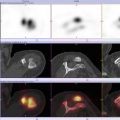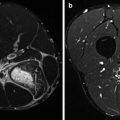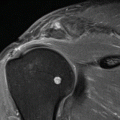© Springer-Verlag Berlin Heidelberg 2015
Andor W.J.M. Glaudemans, Rudi A.J.O. Dierckx, Jan L.M.A. Gielen and Johannes (Hans) Zwerver (eds.)Nuclear Medicine and Radiologic Imaging in Sports Injuries10.1007/978-3-662-46491-5_4646. The Expert View on Tennis Injuries
(1)
Sports Medical Centre Haarlem, Haarlem, The Netherlands
(2)
Royal Netherlands Lawn Tennis Association, Amersfoort, The Netherlands
46.1 Introduction
46.3 Injuries
46.3.1 Upper Extremity Injuries
46.3.2 Trunk, Spine, and (Low) Back
46.3.3 Lower Extremity Injuries
Abstract
Tennis is one of the major global sports, played by people of all ages and at all levels of society. Playing tennis, at no matter what level, places the participant at risk of injury. This chapter provides extensive information regarding tennis injuries and the role of imaging in the diagnostic process.
First, physiological and biomechanical aspects of tennis are briefly illustrated, as well as the epidemiology of tennis injuries. Hereafter, a wide range of tennis injuries is thoroughly discussed, including underlying pathophysiology, the role of imaging, and potential treatment. This part of the chapter is divided into three sections according to anatomical area, distinguishing injuries from the upper extremity, trunk, and lower extremity.
The chapter forms a comprehensive overview of tennis injuries and the role of diagnostic imaging.
Abbreviations
ACL
Anterior cruciate ligament
CT
Computed tomography
ECRB
Extensor carpi radialis brevis
ITF
International Tennis Federation
MRI
Magnetic resonance imaging
RICE
Rest, ice, compression, and elevation
46.1 Introduction
With over 75 million participants worldwide (Pluim et al. 2007), tennis is one of the major global sports. In addition to the active recreational participants, the game is an enormously popular spectator sport, especially the four so-called Grand Slams (Australian Open, French Open, Wimbledon, and US Open). In 1988 tennis officially returned to the Summer Olympics, after being absent since 1924. The International Tennis Federation (ITF) is the governing body of the game of tennis, and its headquarters are located in the southwest of London (http://www.itftennis.com).
Tennis is a noncontact sport played between two players (singles) or between two teams of two players (doubles). A racket is used by each player, enabling the player to hit the hollow rubber ball over a net and into the opponent’s court. The object of the game is to score points by hitting the ball in such a way that the opponent is not able to return it. A player can win the match by gaining “games” and “sets.” Tennis is played by people of all ages and at all levels of society. Wheelchair tennis follows the same rules as able-bodied tennis, except the ball is allowed to bounce twice instead of once in able-bodied tennis.
46.1.1 Physiological Demands of the Game and Biomechanics of Tennis
While there is a set structure to the service, after that unpredictability plays a major role in tennis. It is what makes tennis interesting from a physiological point of view. Due to this variation of shot selection, point and match duration, strategy, weather, and – last but not least – the opponent, there is great variance in physiological demands. During a match, some 300–500 bursts of anaerobic effort may be required, with rest periods between points and games. The mean duration of rallies varies substantially, depending on numerous factors, and is on average between 5 and 15 s. As tennis does not have time limits, matches may last from less than 1 h to over 5 h; this requires athletes to have both high anaerobic and aerobic fitness levels (to aid in recovery during and after play). In summary, tennis might be classified as a predominantly anaerobic activity requiring high levels of aerobic conditioning to aid in recovery between points and to avoid fatigue (Kovacs 2006; Pluim and Safran 2004).
In addition to the abovementioned cardiorespiratory characteristics, tennis demands great speed and agility (when moving over the court), as well as strength (ball velocity) and flexibility (joint range of motion).
Biomechanics also play an important role in tennis. As all strokes (forehand, backhand, service, and volley) are repeated with high frequency, developing proper biomechanics and stroke technique helps to improve efficiency and reduce injury risk. A faulty technique is a major risk factor for injuries. It is a common misconception that muscular strength determines how hard one can hit the ball; “power tennis” is actually the result of the effective biomechanics (e.g., racket speed) and not just muscular strength (Elliott 2006; Pluim and Safran 2004).
46.2 Epidemiology of Tennis Injuries
Playing tennis, at no matter what level, places the participant at risk of injury. A review of the literature reveals a substantial variance in injury incidence, ranging from 0.04 to 3.0 injuries per 1,000 h played (Pluim et al. 2006). Some of this variation may arise from the fact that different definitions of injury have been used in the various studies. A consensus statement was made in 2009 in order to record injuries and illnesses in a more consistent and comparable way (Pluim et al 2009).
Most injuries in tennis occur in the lower extremity (31–67 %), followed by the upper extremity (20–49 %) and the trunk (3–21 %). Acute injuries tend to occur most often in the lower extremity (e.g., ankle sprain, muscle rupture), whereas gradual-onset injuries commonly affect the upper extremity or trunk (e.g., low back pain, rotator cuff tendinopathy, tennis elbow).
Some factors have been shown to increase the risk of injury in tennis. Both volume of play and playing competitive tennis increase the risk. There is no evidence that age, sex, and skill level are associated with a higher risk of injury (Abrams et al. 2012).
46.3 Injuries
46.3.1 Upper Extremity Injuries
Due to the repetitive motion of the serve and ground strokes, overuse injuries of the upper extremity occur frequently in tennis. Acute traumatic injuries may result from a fall onto the arm or hand but are much less common.
46.3.1.1 Shoulder
The fragile equilibrium between mobility and stability in the shoulder is the most important underlying principle in shoulder injuries in tennis. The large range of motion in all directions allows overhead action (e.g., during service), but the repetitive abduction-external rotation movement carries a risk of overloading the various anatomical structures around the shoulder. The kinetic chain, scapular (in)stability, capsulolabral complex, and glenohumeral internal rotation are all considered to play an important role in shoulder injuries (Hoeven and Kibler 2006). Disturbances in one of these factors may lead to internal impingement or labral pathology. In older players, the rotator cuff is more commonly involved, whereas in the young tennis player, shoulder pain is more often due to subtle instability. In the young tennis player, growth plate-related shoulder pain (e.g., epiphysitis humeri) should be taken into account as well. Modifying the training load and strengthening exercises of the scapula and shoulder is the cornerstone of treatment.
46.3.1.2 Elbow
Tennis elbow is a tendinopathy involving the extensor carpi radialis brevis (ECRB) causing lateral elbow pain. It is one of the most common overuse injuries in tennis, especially in recreational players. The overall career incidence has been reported to be between 35 and 51 %. Interestingly, only 5 % of the people with tennis elbow actually play tennis. Within 1 year, 90 % of patients recover, regardless of which treatment is used. Corticosteroid injections offer good short-term results (6–10 weeks) but lead to more recurrences after 1 year compared to wait-and-see policy (Smidt et al 2006; Smidt and Van der Windt 2006). This means that they should be avoided in most cases. As the diagnosis “tennis elbow” is made clinically, diagnostic imaging is rarely required.
Stay updated, free articles. Join our Telegram channel

Full access? Get Clinical Tree







